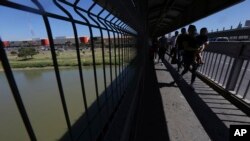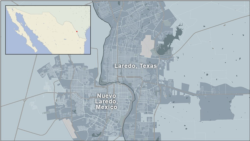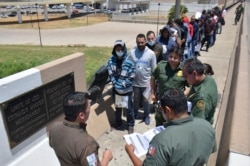Outside observers will not be allowed without permission inside tent courts in South Texas where the Trump administration is processing thousands of migrants forced to wait in Mexico, U.S. officials said Wednesday.
The first hearings under the so-called “Remain in Mexico” program began Wednesday in Laredo, Texas. A small number of migrants will have hearings before the tents in Laredo and Brownsville officially open next week.
The “Remain” program, which the U.S. ramped up this summer with Mexico’s cooperation, has been credited by American officials with driving down the number of migrant apprehensions at the southern border, a key goal of President Donald Trump. But immigration advocates say they’re concerned people seeking asylum and other migrants will be denied fair hearings.
Immigration hearings usually open
U.S. officials Wednesday said outside observers including the news media will not be allowed into the tents without permission. Under U.S. Department of Justice rules, immigration court hearings are generally open to the public, though immigration judges can close some hearings for privacy reasons or to protect “the public interest.”
One official said the government might allow potential observers to submit applications “as we move forward.”
The officials briefed reporters under the condition that they not be identified.
In El Paso, Texas, and San Diego, migrants are taken to immigration court and then bused back to the border if authorities decide they must continue to wait in Mexico. But in South Texas, authorities elected to build tents near international bridges on the property of U.S. Customs and Border Protection.
The tents have a walkway from each bridge that eventually lead to courtrooms with video-conferencing equipment. Immigration judges will hold hearings remotely. The officials said that if attorneys have formally agreed to represent migrants, they will be allowed to attend hearings in person. However, they said outside attorneys who routinely observe immigration proceedings will not be allowed at the hearings.
More than 40,000 waiting
More than 40,000 migrants have been told to wait for their immigration court dates in Mexico since the program went into effect this year.
Many are waiting in Mexican border cities with uncertain access to food and water, under the threat of kidnapping and extortion. While the Department of Homeland Security has pledged not to send people in “vulnerable populations” to wait in Mexico, a Salvadoran woman who was 8½ months pregnant reported that Border Patrol agents took her to the hospital so she could be treated for premature contractions, then forced her to go back to Mexico.
A reporter for BuzzFeed News was denied access to the initial hearings Wednesday in Laredo, as was Ashley Huebner, an attorney at the National Immigrant Justice Center.
“Attorneys aren’t jumping to go in and solicit paying clients in these courts,” Huebner said. “They want to ensure that people’s due process rights are being protected, and there’s no opportunity to do that.”
Kennji Kizuka, an advocate with Human Rights First, called the court restrictions a “due process nightmare.”
“It is just another attempt to cover up the flaws in this sham asylum process, a process created to block refugees from finding safety in the United States,” Kizuka said in a statement.














